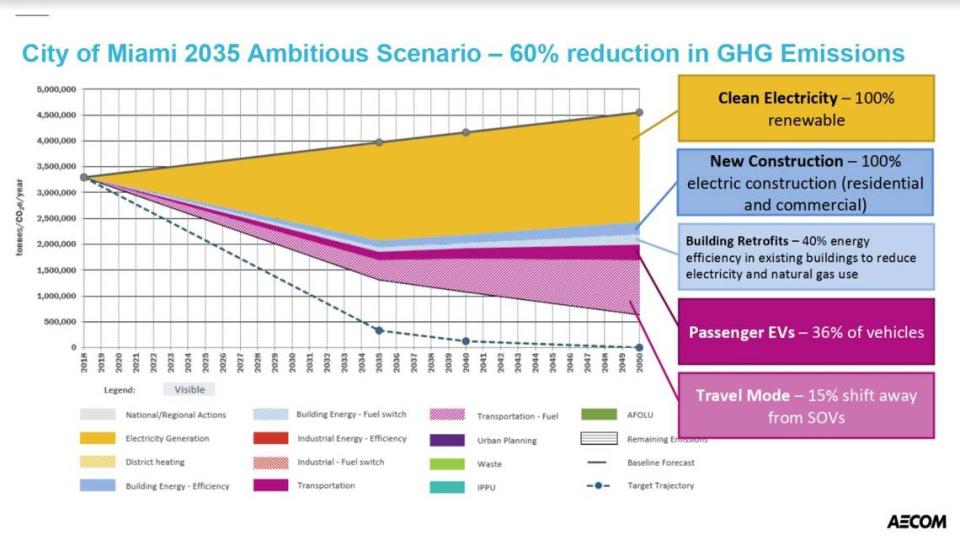Miami wants to slash carbon emissions 60 percent by 2035. How? That’s still up in the air
Miami has plans to slash carbon emissions, and those plans could change the way its residents get around town, cook their food and cool their homes — soon.
Miami is committed to going carbon neutral by 2050, and now the city has identified a halfway mark: reducing greenhouse gas emission by 60% by 2035.
Getting there will require massive changes in a city where most people couldn’t imagine getting around without using a car. Changes like relying completely on renewable energy, eliminating natural gas hookups in all new construction and switching a third of all the cars in the city to electric vehicles. All within the next 14 years.
How — exactly — the city can convince its residents to make these often expensive switches to greener technology is still up in the air.
The phrase “ambitious but achievable” came up often in the Tuesday announcement of the city’s new interim goal, announced a year after the city originally committed to reducing its carbon emissions (the cause of climate change) to zero by 2050.
“Greenhouse gases are the greatest risk to the city of Miami and the entire globe,” said Alan Dodd, the city’s chief resilience officer. “I think the city can absolutely achieve the interim goal, however, it does require people to make choices and to change some ways of doing business.”
The city wants residents’ feedback on what kind of changes they would be willing to put up with, like more solar on city buildings, and which ones they wouldn’t. It’s hosting a series of meetings next week to find out.
Zelalem Adefris, a member of the Miami Climate Alliance, said she was encouraged by the city’s new focus on mitigating climate change rather than simply adapting to it with higher seawalls and more pumps.
“The opportunity to provide a lot of multiple benefits for our community really lies in mitigation,” she said.
She pointed to weatherization programs, which help homeowners plug gaps in leaky windows and upgrade inefficient air conditioners, as an example. Helping homeowners conserve electricity not only reduces emissions but also lowers power bills.

The 60% reduction figure would apply to the city’s 2018 levels of greenhouse gas emissions — about 3.5 million metric tons of carbon dioxide. That includes all cars that travel through the city and the energy used by every home and office within city limits.
Drastically slashing emissions is a tall order, and the biggest piece of that puzzle is the electric grid. Miami’s plan to get to a 60% reduction requires a switch to 100% renewable energy.
In 2018, Miami received 24% of its energy from renewable sources. Most of that was from the Turkey Point Nuclear Generating Station, with only 1.8% from solar. The rest of the energy mostly comes from natural gas.
Florida Power and Light, which provides power for most of the state, only plans on increasing that solar figure to 16% by 2030, according to figures provided to the city.
To get from 16% to 100%, the city is relying on President Joe Biden to enforce his executive order requiring a “carbon pollution-free electricity sector” by 2035. The administration has not released details on how to plans to make that happen.
As Biden pledges climate change action, Florida activists want more while GOP digs in
If the city receives all of its energy from renewable sources by 2035, the work falls to eliminating natural gas and shifting the way people get around, said Alissa Farina, Miami’s resilience programs manager.
Natural gas makes up a majority of the state’s power grid, but it’s also used for water heaters and stoves. To meet its goal, the city has to change laws to require that all new construction use electricity to power those devices, not natural gas. Miami would also have to ensure that about 40% of all buildings in the city are retrofitted to convert those natural gas systems to electricity.
Farina sees the transportation side of the puzzle as the most challenging, especially since it makes up about 43% of the city’s total emissions.
Miami identified two changes to transportation by 2035: 36% of all cars in the city would have to be electric and 15% of people that use cars would have to switch to options like public transportation or biking for their daily commute.
The city can do some things independently, like switching its own fleet of publicly owned cars to electric, along with trolleys and buses, but the rest of that change will be tougher.
“There’s no direct way we can do that. It requires behavioral change,” Farina said. “We’re going to do what we can. We’re going to try and work as collaboratively as possible.”
Miami plans to release a draft climate action plan on April 22, Earth Day.
Miami is hosting three Zoom meetings to solicit public feedback on its greenhouse gas reduction plan. They’re scheduled for 7 pm on March 2, March 3 and March 4. Residents can sign up on www.miamigov.com/ghgplan.

